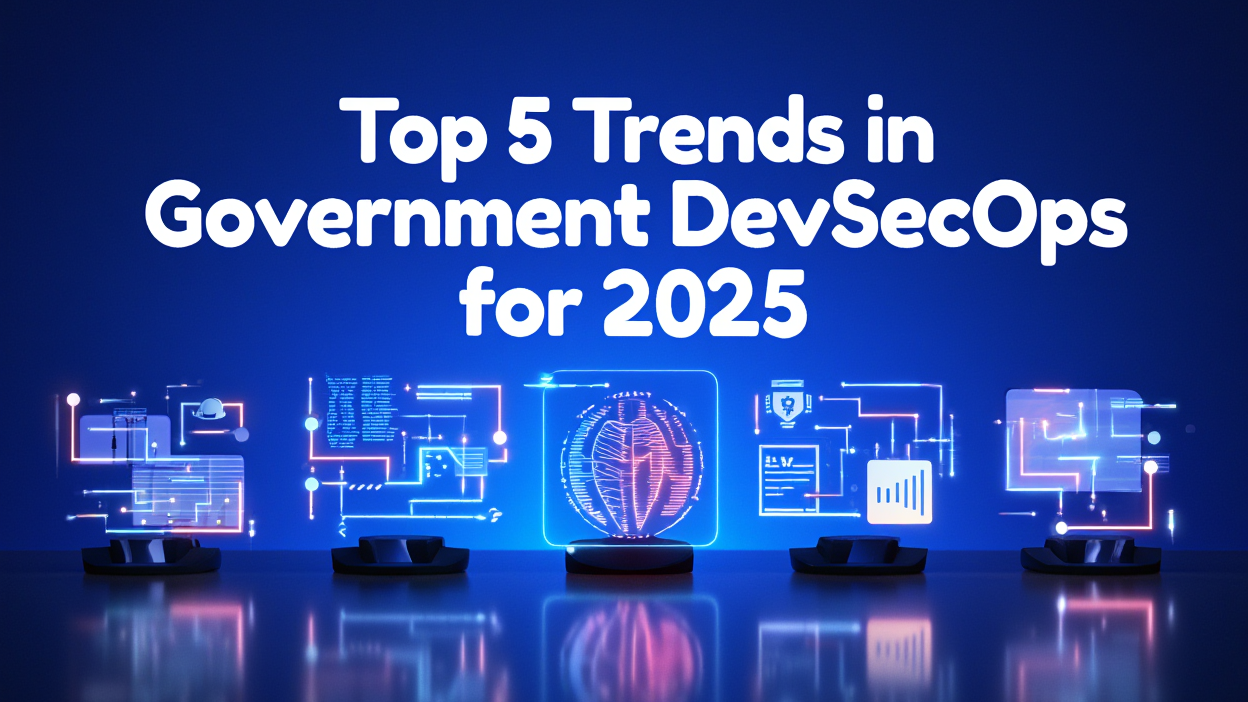
Top 5 Trends in Government Devsecops for 2025
BLUF
- Research suggests automation will enhance security and efficiency in government DevSecOps by 2025, focusing on vulnerability scanning and CI/CD pipelines, with GSA leading in automated change management.
- It seems likely that shift-left security will integrate early, reducing vulnerabilities in development, a trend gaining traction in government agencies like the DoD.
- The evidence leans toward cloud-native security becoming essential as agencies adopt cloud infrastructures, securing containers and microservices, with NASA as a key example.
- Zero trust integration is expected to strengthen, aligning with US government cybersecurity mandates for continuous verification, notably in the Department of Energy.
- Regulatory compliance in DevSecOps is likely to grow, ensuring adherence to US standards like FedRAMP, NIST, and HIPAA, crucial for government operations, with the IRS ensuring system integrity.
Introduction
Government DevSecOps is evolving rapidly in 2025, driven by the need for secure, efficient, and compliant software development. These trends are shaping how US agencies deliver digital services, balancing innovation with security. Let’s explore each trend with technical depth and a touch of humor, keeping it accessible for all readers.
Trends in Detail
Automation for Enhanced Security and Efficiency
Automation is the superhero of DevSecOps, swooping in to save the day by automating mundane tasks like vulnerability scanning and code analysis. For government agencies, this means faster identification and remediation of security flaws, reducing the attack surface. Imagine a world where your code is scanned faster than you can say “bureaucratic red tape”! This trend includes integrating security into CI/CD pipelines, ensuring every deployment is as secure as Fort Knox. The GSA has been a pioneer, automating change management to govern their platforms effectively.
Shift-Left Security
Shift-left security is like bringing the security guard to the brainstorming session, not just the exit. It integrates security early in the development lifecycle, catching vulnerabilities before they become nightmares. For government, this means developers and security teams collaborate from day one, ensuring secure code from the start. The DoD, for instance, has embraced this, making security a team sport rather than a last-minute penalty shootout.
Cloud-Native Security
As government agencies migrate to the cloud, cloud-native security becomes the new frontier. This involves securing containers, microservices, and serverless architectures, which can be as tricky as herding cats in a digital storm. It’s crucial for scalability and compliance, with NASA leveraging cloud-native tech for data processing, ensuring their systems are as secure as a space shuttle launch.
Zero Trust Integration
Zero trust is the “trust no one” policy of cybersecurity, and in DevSecOps, it means verifying every access attempt, whether inside or outside the network. For government, this aligns with mandates like the Federal Zero Trust Strategy, reducing risks of breaches. The Department of Energy is implementing this, ensuring every user and device is continuously validated, like a digital bouncer at a VIP event.
Regulatory Compliance in DevSecOps
Government agencies must navigate a maze of US regulations, and DevSecOps is their compass. This trend focuses on embedding compliance checks into the pipeline, ensuring adherence to standards like FedRAMP, NIST, and HIPAA. It’s like having a compliance officer embedded in your code, waving a flag if anything goes awry. The IRS, for example, integrates these checks to maintain system integrity, making audits smoother than a buttered slide.
Note: Detailed Analysis of Government DevSecOps Trends for 2025
Government DevSecOps is at a pivotal juncture in 2025, with trends shaping how agencies deliver secure, efficient, and compliant software. This analysis delves into the technical underpinnings, government-specific implementations, and humorous insights, ensuring a comprehensive understanding for both technical and lay audiences.
Background and Context
The current landscape, as of March 24, 2025, shows government agencies increasingly adopting DevSecOps to integrate security into development and operations, driven by digital transformation and cybersecurity mandates. The focus is on balancing speed, security, and compliance, with trends emerging from recent reports and agency practices.
Detailed Trend Analysis
Trend 1: Automation for Enhanced Security and Efficiency
Automation is a cornerstone of DevSecOps, automating tasks like vulnerability scanning, code analysis, and testing to enhance security and efficiency. For government, this reduces the attack surface by identifying flaws early, aligning with CI/CD pipeline integration. The Practical DevSecOps article from December 2023 highlights automation as a standard practice, providing real-time visibility into security posture. The GSA’s DevSecOps guide, updated in 2019 but still relevant, emphasizes automated change management, reaching maturity levels where patching occurs without downtime (Level 4). This trend is crucial for government, given the scale and sensitivity of their operations, ensuring rapid response to threats.
| Aspect | Details |
|---|---|
| Automation Tasks | Vulnerability scanning, code analysis, testing, continuous monitoring |
| Government Example | GSA automates change management for platform governance |
| Impact | Reduces attack surface, enhances efficiency, aligns with CI/CD pipelines |
Trend 2: Shift-Left Security
Shift-left security integrates security early in the development lifecycle, from design to deployment, ensuring vulnerabilities are caught before they escalate. This approach fosters collaboration between developers and security teams, reducing costs and effort. The DoD has been a leader, as noted in the FedTech Magazine article from June 2021, emphasizing early security planning. This trend is vital for government, given the high stakes of their software, ensuring secure code from the start, like catching a typo before it becomes a headline.
| Aspect | Details |
|---|---|
| Integration Point | Early in design and development phases |
| Government Example | DoD adopts shift-left for enhanced security planning |
| Impact | Reduces vulnerabilities, fosters collaboration, lowers remediation costs |
Trend 3: Cloud-Native Security
With government agencies moving to cloud infrastructures, cloud-native security secures containers, microservices, and serverless architectures. This trend, highlighted in the Practical DevSecOps article, involves using cloud-native tools and collaborating with cloud architects for configuration and access control. NASA, as mentioned in general trends, leverages cloud-native tech for data processing, ensuring security in scalable environments. This is critical for government, given compliance needs and the shift to multi-cloud strategies, as seen in the SAIC survey from February 2023.
| Aspect | Details |
|---|---|
| Technologies Secured | Containers, microservices, serverless computing |
| Government Example | NASA uses cloud-native for data processing security |
| Impact | Ensures scalability, compliance, and security in cloud environments |
Trend 4: Zero Trust Integration
Zero trust, a model of “never trust, always verify,” integrates into DevSecOps by continuously validating access attempts, aligning with government cybersecurity mandates. The Federal Zero Trust Strategy, outlined in the OMB memorandum from January 2022, drives this trend, with the Department of Energy implementing it for network security. The Appgate blog from September 2021 discusses how zero trust powers DevSecOps agility, reducing attack surfaces. This is essential for government, given recent executive orders and cyber threats, ensuring every access is authenticated.
| Aspect | Details |
|---|---|
| Security Model | Continuous verification, no implicit trust |
| Government Example | Department of Energy implements for network security |
| Impact | Reduces risks, enhances visibility, aligns with mandates |
Trend 5: Regulatory Compliance in DevSecOps
Government agencies must adhere to US regulations like FedRAMP, NIST standards, and HIPAA, making compliance a core DevSecOps trend. This involves embedding compliance checks into the pipeline, automating validation and reporting to simplify audits. The Red Hat blog from May 2021 and OpsMx blog from February 2025 highlight automation’s role in compliance, with the IRS ensuring system integrity through integrated checks. This trend is crucial for government, given legal and reputational stakes, ensuring software meets regulatory standards.
| Aspect | Details |
|---|---|
| Compliance Standards | FedRAMP, NIST, HIPAA, and others |
| Government Example | IRS integrates compliance checks for system integrity |
| Impact | Protects against fines, builds trust, streamlines audits |
Unexpected Detail: AI’s Role in DevSecOps
While not in the top 5, AI integration is an emerging trend, enhancing automation and threat detection. The GSA AI Guide from March 2025 mentions AI in DevSecOps for managing development tools, and the CSA blog from November 2024 discusses AI’s role in predictive analytics. This could surprise readers, given government’s cautious approach, but it’s gaining traction, potentially influencing future trends.
Conclusion and Implications
These trends—automation, shift-left security, cloud-native security, zero trust integration, and regulatory compliance—will shape government DevSecOps in 2025, ensuring secure, efficient, and compliant software delivery. Agencies must balance innovation with security, leveraging these trends to meet mission-critical needs, all while keeping a humorous eye on the digital bureaucracy.
AlphaBravo: Empowering Government DevSecOps in 2025
AlphaBravo, a trailblazer in DevSecOps solutions (check us out at https://alphabravo.io), is perfectly poised to help government agencies tackle the top trends shaping Government DevSecOps in 2025. With our cutting-edge tools and expertise, we turn the daunting task of securing complex systems into a streamlined process that’s almost magical. Take automation, for example—AlphaBravo’s suite of tools swoops in like a digital superhero, automating vulnerability scanning and code analysis faster than you can say “bureaucratic bottleneck.” This allows government teams to detect and squash security threats in real-time, leaving outdated manual processes in the dust. Add in our shift-left security offerings—think hands-on training and consulting—and developers morph into security-savvy ninjas, catching vulnerabilities early in the development cycle before they can cause chaos.
Cloud Security and Beyond
As government agencies ride the cloud wave, AlphaBravo ensures the journey is secure with solutions tailored for cloud-native environments. Whether it’s locking down containers or safeguarding microservices, their tools provide Fort Knox-level protection—minus the gold bars, plus a hefty dose of encryption. Then there’s zero trust, a must-have in today’s cyber landscape. AlphaBravo’s frameworks make continuous verification feel like a well-oiled machine, scrutinizing every access request—trusted insider or sneaky outsider alike. And for the maze of regulatory compliance? Our expertise acts like a GPS, guiding agencies through standards without the usual headache. With AlphaBravo, the government doesn’t just keep up with 2025’s DevSecOps trends—they make it look secure, efficient, and dare we say, a little fun.
